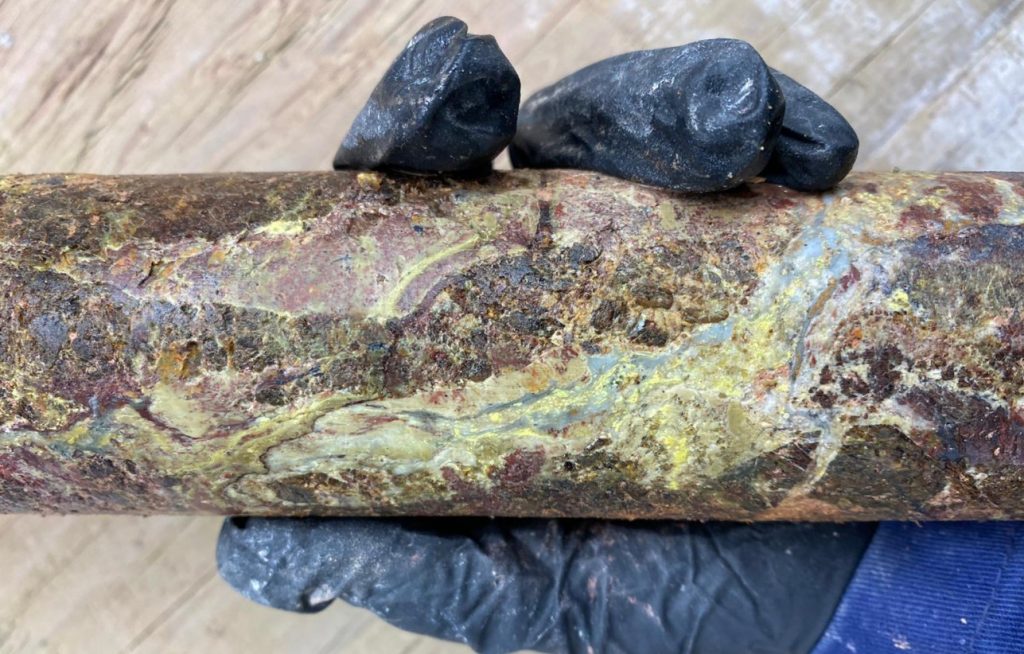Baselode Energy drills 0.32% U3O8 over 16.5 metres at Hook, Saskatchewan

Baselode Energy Corp. [FIND-TSXV; BSENF-OTCQB] reported uranium (U3O8) assay results from 11 drill holes (AK23-81 to AK23-91) of the 7,500-metre diamond drilling program targeting the deepest parts of the Ackio high-grade uranium system (Ackio) on the Hook project, Athabasca basin, northern Saskatchewan.
The assays reported herein are all from the deepest drilling at Ackio. Baselode anticipates, based on previously released radioactivity results, to release even more encouraging results from shallower intersections with pending assay results from 25 drill holes remaining.
AK23-88 returned 0.32% U3O8 over 16.5 metres at 184 metres drill hole depth, including 0.53% over 3.0 metres and 0.75% over 1.5 metres (best uranium intersection beneath 150 metres depth). Mineralization remains open at depth. Assays from 25 remaining drill holes on this program are pending.
“The results from the deep targets in drill holes AK23-88 and AK23-82 clearly demonstrate mineralization remains strong and open at depth as we attempt to connect the near-surface mineralization with these new zones at depth. The assay results from hole AK23-88 rank it is a top-10 drill hole at Ackio. In particular, AK23-88 intersected four individual high-grade uranium lenses, including 0.53% over 3.0 metres and 0.75% over 1.5 metres, while holes AK23-84 through AK23-88 demonstrate continuity of higher grades of mineralization at depth. Ackio is a robust uranium system with shallow mineralization extending deep and remains open for additional discovery potential,” said James Sykes, CEO, president and director of Baselode.
Thirty-six drill holes over 7,512 metres were completed. Within this, Ackio consisted of 30 drill holes for 6,193 metres, Mirror consisted of five drill holes for 1,145 metres (AK23-105 to AK23-109), and one drill hole (HK23-008) for 174 m was completed on a regional exploration target.
Drill holes AK23-90 and AK23-91 confirmed mineralization starting at 72 metres and 82 metres below surface, respectively, demonstrating shallow mineralization is prevalent in other Pods at Ackio.
The remainder of the drill hole assay results were all intersected between 130 and 225 metres beneath the surface, demonstrating uranium mineralization is prevalent at depth at Ackio and is not restricted to shallow mineralization. Mineralization remains open at depth and provides a target for future drill programs.
Four of the reported drill holes (AK23-84 to AK23-88, excluding AK23-87) all intersected high-grade uranium mineralization (in example, greater than 0.50% U3O8) over a minimum width of 0.5 metres core length. These results continue to demonstrate high-grade uranium occurs at depth Ackio.
Three drill holes (AK23-82, AK23-86, AK23-88) all intersected continuous mineralization over 10 metres core length, demonstrating thick mineralized zones at depth.
Ackio is 30 km southeast of well-established infrastructure, including an all-season road and powerline between Cameco Corp.’s and Orano’s McArthur River mine and Key Lake uranium mill joint ventures. Ackio is 70 km northeast of the Key Lake mill. The program was helicopter supported to lessen any ground-induced environmental impacts within the project area.
All reported drill hole lengths do not represent true thicknesses which have yet to be determined. “High-grade uranium mineralization” is defined by the company as any result with greater than 0.50% U3O8 over a minimum of 0.25-metre drill hole interval.
Baselode controls 100% of approximately 264,172 hectares for exploration in the Athabasca basin area, Northern Saskatchewan. The land package is free of any option agreements or underlying royalties.
The company discovered the Ackio near-surface, high-grade uranium deposit in September 2021. Ackio measures greater than 375 metres along strike, greater than 150 m wide, comprising at least 11 separate zones, with mineralization starting as shallow as 28 metres beneath the surface and down to approximately 300 m depth beneath the surface with the bulk of mineralization occurring in the upper 120 metres. Ackio remains open to the west, north, south and along the Athabasca sandstone unconformity to the east and south.
Baselode’s Athabasca 2.0 exploration thesis focuses on discovering near-surface, basement-hosted, high-grade uranium orebodies outside the Athabasca basin. The exploration thesis is further complemented by the company’s preferred use of innovative and well-understood geophysical methods to map deep structural controls to identify shallow targets for diamond drilling.
